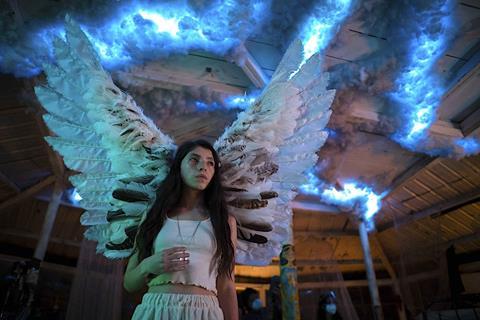Jayro Bustamante takes inspiration from a real-life Guatemalan children’s home tragedy for this follow-up to ’La Llorona’

Dir/scr: Jayro Bustamante. Guatemala. 2024. 107mins
Fantasy realms have long provided children with a retreat from the harsh reality of their lives, and in this immersive magic realist fable from Jayro Bustamante the actual and the imagined run a hair’s breadth apart. Life has been no fairytale for 13-year-old Rita (Giuliana Santa Cruz), who is being dropped off at a children’s home for girls for her ‘protection’ after being caught running away from her abusive family life.
Largely avoids outright visual horror in favour of more atmospheric unease
The idea of protection, or rather the lack of it, runs through Bustamante’s fourth feature (following Ixcanul, Tremors and La Llorona) which draws us into the children’s world as they take on everyday horrors that lie outside their control. Rita is a direct response to a real-life tragedy at a Guatemalan children’s home in 2017, which saw 41 girls lose their lives with no responsibility being taken by the authorities afterwards, and Bustamante says he hopes the film will be a “rallying call for justice”. His decision to embed this heart-rending call-to-action within an accessible fantasy framework is likely to ensure it reaches a wide audience when it comes to streamer Shudder (who have US/Canada and UK rights) in November, following its Fantasia premiere.
The fantastical is present from the moment Rita sets foot in the home. She spots a group of ghost-like figures shrouded in black and surrounded by glimmering lights, whose true nature is revealed later. Each girl is assigned to a dedicated room, from princesses to rabbits. Rita enters the quarters occupied by ’angels’, where she is befriended by Bebe (Alejandra Vasquez), Sulmy (Angela Quevedo) and leader La Terca (Isabel Aldana) – the wings on their backs an indication that they take these designations to heart.
The supernatural has hovered at the edge of Bustamante’s previous work, with earthquakes shaking up Tremors and the weeping woman myth haunting his consideration of the aftermath of genocide in La Llorona. Now he allows the fantastical to fully spread its wings. Like Guillermo del Toro – whose Pan’s Labyrinth and The Devil’s Backbone occupy a similar genre environment – Rita is about children but not intended for them, even though Bustamante largely avoids outright visual horror in favour of more atmospheric unease.
The girls in the ‘angel’ room have feathery wings – something Rita initially spurns – while girls labelled fairies have a glittery equivalent, the rabbits sport ears and so on. It lends the film a tribal feel, where the unified stance of the children in the face of exploitation is key. Even an early hazing sequence that leaves Rita battered is shown to have a more positive ulterior motive as the girls reveal plans for escape.
The adult world represents little but danger. The matron (Sabrina De La Hoz) is as close to normal as anyone gets, but the black-clad social worker (Margarita Kenefic), with her long hair and accusatory attitude, could scarcely be more witch-like from a child’s perspective. Worse still are the male guards, who view the girls as sexual targets and commodities to be traded via photos online.
Costume design from Fernando Galvez and production design from Angelica Perea tread a fine line so that while the children’s outfits are impressively fantastical, they retain enough of a childlike element to feel as though they have sprung from the imaginations of the youngsters. This less sophisticated aspect also acts as a reminder that, no matter how strong the children’s protective mythology may be, they remain acutely vulnerable in a physical sense.
Bustamante avoids glorifying violence by leaving it mostly implied. The writer/director stands in solidarity with the girls, showing how their carefully crafted world acts as a shield against the abusive incursions of the adults. He never lets us forget, however, that this is not a fairytale. It’s particularly jarring to see technology, including camera LED light rings and WhatsApp, being used to exploit the girls. It’s also a sharp reminder this is neither make believe, nor something from the distant past. That some adults also seem aware of the children’s various costumes is additionally disturbing, indicating that, while the kids have absorbed them into their world view, the wings and other outfits were originally introduced by the grown-ups – perhaps to feed their own sordid fantasies.
The mood falters a little when the action briefly leaves the confines of the home, but Bustamante is aiming for and largely achieves an aura of sustained rather than mounting tension. His real-world ogres and witches are far more dangerous than those contained within books, and happy endings are far from guaranteed.
Production companies: Concordia
International sales: Upgrade Productions, Jonathan Kier info@upgradeprods.com
Producers: Jonathan King, Gustavo Matheu, Jayro Bustamante
Cinematography: Inti Briones
Production design: Angelica Perea
Editing: Gustavo Matheu, Jayro Bustamante
Music: Pascual Reyes
Main cast: Giuliana Santa Cruz, Alejandra Vasquez, Angela Quevedo, Isabel Aldana, Sabrina De La Hoz, Margarita Kenefic, Ernesto Molina, Maria Telon





















